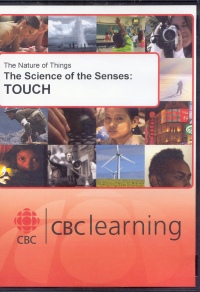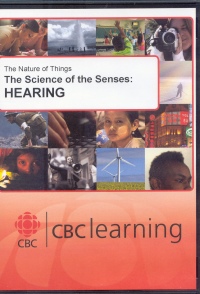| ________________
CM . . .
. Volume XVIII Number 36. . . .May 18, 2012

 |
The Science of the Senses: Sight. (The Nature of Things).
Toronto, ON: CBC Learning (www.cbclearning.ca), 2008.
45 min., DVD, $466.00 for the series, Single episode price $150.00 (Single site license price).
Series Product ID WOF-07-13. Episode Product ID WOF-07-09.
Grades 10 and up / Ages 15 and up.
Review by Joanne Peters.
**** /4
|
| |
|
 |
The Science of the Senses: Touch. (The Nature of Things).
Toronto, ON: CBC Learning (www.cbclearning.ca), 2008.
45 min., 30 sec., DVD, $466.00 for the series, Single episode price $150.00 (Single site license price).
Series Product ID WOF-07-13. Episode Product ID WOF-07-07.
Grades 10 and up / Ages 15 and up.
Review by Joanne Peters.
**** /4
|
| |
|
 |
The Science of the Senses: Hearing. (The Nature of Things).
Toronto, ON: CBC Learning (www.cbclearning.ca), 2008.
45 min., 30 sec., DVD, $466.00 for the series, Single episode price $150.00 (Single site license price).
Series Product ID WOF-07-13. Episode Product ID WOF-07-06.
Grades 10 and up / Ages 15 and up.
Review by Joanne Peters.
**** /4
|
| |
|
 |
The Science of the Senses: Smell/Taste. (The Nature of Things).
Toronto, ON: CBC Learning (www.cbclearning.ca), 2008.
45 min., 30 sec., DVD, $466.00 for the series, Single episode price $150.00 (Single site license price).
Series Product ID WOF-07-13. Episode Product ID WOF-07-08.
Grades 10 and up / Ages 15 and up.
Review by Joanne Peters.
**** /4
|
| |
|

Sight, hearing, touch, taste, and smell - through these five senses, we perceive our world, in all of its complexity. The four episodes which comprise The Sciences of the Senses take its viewers on tours of the neural pathways which lead to the brain, the central processing unit for the information received through the eyes, ears, hands and skin, tongue and the nose. This series, from CBC's television program, The Nature of Things, offers accessible scientific content, profiles of current scientific research, as well as the personal stories of individuals who either face perceptual difficulties or demonstrate extraordinary talent, in one of their senses.
At the beginning of the episode entitled Sight, narrator David Suzuki asks, "What would our world be, without its endless gift, without that international language of the soul, spoken only by the eyes?" Sight is crucial to an understanding of our world, to understanding of others (through our "reading" of facial expressions or physical gestures), and to imaginative creation. The neural pathways which decode visual images occupy more than half of the human brain, yet sight is the last of our senses to develop, as it has no uterine stimuli. Given the primacy of sight, what happens in the brains of those who are blind? Research into the science of the brain offers some hope because of cortical "plasticity" which enables other parts of the brain to compensate for the loss of visual stimuli. Even when one can see, other impairments can be as disabling as cortical blindness: a small percentage of people are "face-blind" and cannot read emotion in the faces of others. Even more rarely, some are incapable of recognizing faces at all, regardless of how familiar they might be (including their own). As one face-blind individual states, "It makes me feel less connected than other people. I can be standing right next to someone I know and not know that I know them." It's a rare genetic condition, but a significant, nonetheless. Vision is complex and loss of any of its component dimensions is clearly disabling.
Those who lose their sight often can compensate through tactile stimuli, and in the episode entitled Touch, a blind woman's ability to perceive the surface of objects through her sense of touch enables her to create drawings which have both dimension and perspective. Two other individuals are profiled in this episode: Ian Waterman, a British farmer who, at age 19, completely lost his sense of touch after a viral infection, and Vitor Meira, a racing car driver whose sense of touch is hyper-sensitive. Despite having lost all sense of touch below the neck, as well as his sense of where his body is in space, Waterman has used a variety of visual cues to re-learn how to drive a tractor, write on the shells of eggs (in order to identify hatchlings), and to walk. For Meira, an acute sense of touch means that he can "feel everything that the car is doing, every vibration, every bump in the road. . . . [he has] to become one with the car."
These individuals show that touch can be integrated with other senses, such as sight and sound. Just as someone with neurological impairment can teach himself to compensate for the loss of touch, conversely, great athletes have developed their tactile sensory system to the extreme. Milt Stegall, a former all-star receiver for the Winnipeg Blue Bombers football team describes this blending of senses: "you catch the ball with your eyes", not the hands. Even members of the audience at a sports event will move in rhythm to the action on a playing field, their brains simulating the action. Touch is also more than perceiving texture or determining the relative position of an object in space. It is also the ability to use our limbs, and especially, our fingers, to perform tasks of extraordinary delicacy: disarming and disposing of bombs, or utilizing robotic assists for micro-surgery. Understanding the neural interface between vision, hearing, and tactile sense, enables researchers to develop prosthetic devices which replicate a human being's haptic (i.e. tactile) system.
Hearing is the second sense to develop in the womb, and it orients us in the world. Hunter-gatherers survived by listening carefully to the sounds of their environment. Today, our world is so full of sound that we use all manner of technologies to filter or even to shut out sound entirely. The extraordinary collection of sounds known as music is a uniquely human invention, and its power to evoke emotion is profound. Still, there are people who can hear sound, but cannot recognize music. Something in their brains prevents them from enjoying that rush of dopamines which makes music "chocolate for the ears." It is the brain which hears - which makes sense of the words we speak or the sounds which musicians produce. However, deafness, the inability to hear sound, is purely about the ear. In the ear, a complex system of nerve endings and tiny bones convey sounds to the brain, and, if there is any flaw in that system, hearing impairment results.
However, scientific research into how the brain hears, coupled with technological advancement has changed the world of the deaf. In the episode Hearing, cochlear implants enable a deaf child to hear his mother's voice for the first time. Understandably, he is distressed, and when he cries and hears the sound of his own voice, he cries even more. Still, children who undergo cochlear implants at an early age experience remarkable development in their ability to perceive speech and to reproduce vocal sounds clearly. Interestingly, hearing aids of any sort are eschewed by Dame Evelyn Glennie, a world-renowned percussionist who has been deaf throughout her adult life; sight, and more importantly, touch, guide her "hearing" of musical sound. She believes that "the body is an instrument" and has taught herself to "hear" the vibration of sound with her whole body.
Loss of sight and hearing are typically regarded as profound challenges. Loss of the sense of touch is a rarity. From time to time, some of us have lost our sense of taste, perhaps because a cold or similar respiratory illness impairs our sense of smell. Still, loss of either of those two senses is rarely given much thought, and much less is it experienced permanently. But, like sight and hearing, both of these senses would also have been acutely necessary for human survival. How else would humans know that food is fresh or that smoke indicates a potentially dangerous situation? In Taste and Smell, we learn about the ways in which smell and taste combine in our brains to create our sense of flavour. The papilli on the surfaces of our tongues can distinguish a limited number of tastes - sweet, sour, salty, savoury, and bitter - which send neural impulses to the brain. However, airborne molecules stimulate cells in the nose, and the impulses from those cells combine with tastes to create perception of flavour.
Smell and taste are pretty much taken for granted until they are lost. Imagine being a wine consultant who can no longer "nose" a glass. Conversely, imagine the culinary possibilities open to a chef who is a "super-taster," whose sense of smell and taste are hyper-acute. But, there's more to smell and taste than great vintages and dazzling plates; smell is a primal sense, capable of evoking powerful memories, as well as conveying sexual attractiveness. Of all the senses, smell and taste are the least studied by the scientific community, and their loss has not been given much concern, despite the psychological distress they can cause. And for Pam Cathrae, the former wine consultant who has lost her sense of smell and whose taste repertoire has vastly diminished, that distress is profound. This episode of The Science of the Senses concludes with master chef Claudio Aprile creating a meal designed to evoke sensory response from Pam. Carlo's meal is a culinary tour de force, a feast for the eyes, as well as the taste buds. Pam does enjoy her beef tenderloin - its texture is perfect, and texture is one component of taste to which she can still respond. As for Claudio, although frustrated with having evoked such a limited enjoyment of the meal, he is happy that some aspect of the meal has been appreciated. Taste and smell are so important to him that he would rather lose the ability to walk than his sense of taste and smell.
The Science of the Senses is most likely to be used in senior high school biology classes. Although not overly technical, the content will be more readily understood by students conversant with human physiology. Each episode runs for about 45 minutes, just the right amount of time for most classes, and each episode is also broken into multiple chapters, further lending itself to classroom use. All four episodes should be purchased as a set, not only because the sensory systems complement and reinforce each other, but also because there is content that would be useful for other disciplines. Art classes can certainly benefit from learning how we see what we see, as well as understanding how the blind can create visual art, and music classes will gain much from the work of world class neuroscientists such as Daniel Levitin (author of This is Your Brain on Music), as well as Dame Glennie's total-body perception of musical sound. And the episode Taste and Smell is a must-see for the serious foodie!
Highly Recommended.
Joanne Peters, a retired teacher-librarian, lives in Winnipeg, MB.

To comment
on this title or this review, send mail to cm@umanitoba.ca.
Copyright © the Manitoba Library Association. Reproduction for personal
use is permitted only if this copyright notice is maintained. Any
other reproduction is prohibited without permission.
NEXT REVIEW | TABLE OF CONTENTS FOR THIS ISSUE
- May 18, 2012.
AUTHORS | TITLES | MEDIA REVIEWS | PROFILES | BACK ISSUES | SEARCH | CMARCHIVE | HOME
|



